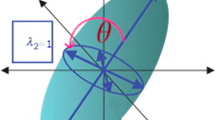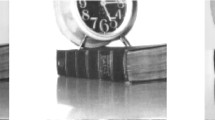Abstract
Prior model is widely applied in the area of computer vision and computer graphics. However, there is still a lack of a general theoretical scheme for evaluating the performance of the priors and a guidance for choosing suitable models. In this paper, a general scheme is proposed for linear singular problems based on the idea of Null Space Compensation. It is proved that for a linear prior model the principal directions obtained from the singular value decomposition of the model shall not be parallel to those of the system matrix determined by the problem. It is also suggested that for a nonlinear prior, higher correlation between the null space components of the estimate data based on the given prior and those of the ground truth or controlled data indicate the better suitability of the prior. The proposed evaluation scheme is demonstrated through an application to a linearized shape from shading problem, where surface shall be reconstructed from single 2D images. Both linear model and nonlinear constraints are evaluated with experiments on both synthetic images and real images. The results validate the proposed evaluation scheme and its capability for guiding in choosing a good prior model structure.
Similar content being viewed by others
References
Blanz, V., Vetter, T.: A morphable model for the synthesis of 3D faces. In: Proceedings of the 26th Annual conference on Computer Graphics and Interactive Techniques, pp. 187–194 (1999)
Chen, L.-F., Liao, H.-Y.M., Ko, M.-T., Lin, J.-C., Yu, G.-J.: A new LDA-based face recognition system which can solve the small sample size problem. Pattern Recognit. 33, 1713–1726 (2000)
Durá, E., Bell, J., Lane, D.: Reconstruction of textured seafloors from side-scan sonar images. In: IEE Proceedings of Radar Sonar Navigation, vol. 151, no. 2, pp. 114–126 (2004)
Horn, B.K.P.: Height and gradient from shading. Int. J. Comput. Vis. 5(1), 37–75 (1990)
Horn, B.K.P., Brooks, M.J.: The variational approach to shape from shading. Comput. Vis. Graph. Image Process. 33, 174–208 (1986)
Huang, R., Liu, Q., Lu, H., Ma, S.: Solving the small sample size problem of LDA. In: ICPR02, vol. 3, pp. 29–32 (2002)
Ikeuchi, K.: Numerical shape from shading and occluding boundaries. Artif. Intell. 17, 141–184 (1981)
Johnson, A.P., Kingdom, F.A.A., Baker, C.L. Jr.: Spatiochromatic statistics of natural scenes: First- and second-order information and their correlational structure. J. Opt. Soc. Am. A, Opt. Imaging Sci. Vis. 22(10), 2050–2059 (2005)
Kube, P., Pentland, A.: On the imaging of fractal surfaces. IEEE Trans. Pattern Anal. Mach. Intell. 10(5), 704–707 (1988)
Liao, I.Y., Petrou, M., Zhao, R.: A fractal-based relaxation algorithm for shape from terrain image. Comput. Vis. Image Underst. 109(3), 227–243 (2008)
Liao, Y., Zhao, R.C.: A Novel Method for Solving Shape from Shading (SFS) Problem. Springer Lecture Notes Computer Science, vol. 4222, pp. 714–723. Springer, Berlin (2006)
Liu, H.: Derivation of surface topography and terrain parameters from single satellite image using shape-from-shading technique. Comput. Geosci. 29, 1229–1239 (2003)
Okatani, T., Deguchi, K.: On the classification of singular points for the global shape from shading problem: A study of the constraints imposed by isophotes. Lect. Notes Comput. Sci. 1351, 48–55 (1997)
Pan, T.S., Yagle, A.E.: Numerical study of multigrid implementations of some iterative image reconstruction algorithms. IEEE Trans. Med. Imaging 10(4), 572–588 (1991)
Pentland, A.: Fractal-based description of natural scenes. IEEE Trans. Pattern Anal. Mach. Intell. 6(6), 661–674 (1984)
Pentland, A.: Shape information from shading: a theory about human perception. In: Proceedings of International Conference on Computer Vision, pp. 404–413 (1988)
Prados, E., Faugeras, O.: Shape from shading: A well-posed problem? In: CVPR 2005, vol. 2, pp. 870–877 (2005)
Salzmann, M., Noguer, F.-M., Lepetit, V., Fua, P.: Closed-form solution to non-rigid 3D surface registration. In: ECCV2008, pp. 1–14 (2008)
Salzmann, M., Pilet, J., Ilic, S., Fua, P.: Surface deformation models for non-rigid 3D shape recovery. Pattern Anal. Mach. Intell. 29(8), 1481–1487 (2007)
Szeliski, R., Terzopoulos, D.: From splines to fractals. Comput. Graph. 23(3), 51–60 (1989)
Turner, M.J., Blackledge, J.M., Andrews, P.R.: Fractal Geometry in Digital Imaging. Academic Press, San Diego (1998)
Worthington, P.L., Hancock, E.R.: New constraints on data-closeness and needle map consistency for shape-from-shading. IEEE Trans. Pattern Anal. Mach. Intell. 21(12), 1250–1267 (1999)
Zhang, R., Tsai, P., Cryer, J.E., Shah, M.: Shape from shading: a survey. IEEE Trans. Pattern Anal. Mach. Intell. 21(8), 690–706 (1999)
Zhao, W.Y., Chellappa, R.: Symmetric shape-from-shading using self-ratio image. Int. J. Comput. Vis. 45(1), 55–75 (2001)
Author information
Authors and Affiliations
Corresponding author
Rights and permissions
About this article
Cite this article
Liao, I.Y., Zaman, M. Prior model evaluation from Null Space Compensation perspective with application to surface reconstruction from single images. Vis Comput 26, 997–1005 (2010). https://doi.org/10.1007/s00371-010-0433-2
Published:
Issue Date:
DOI: https://doi.org/10.1007/s00371-010-0433-2




